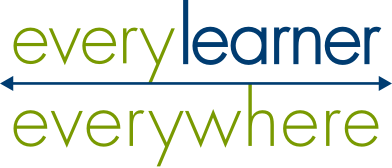Every Learner Everywhere strives to use equity-centered language in its published material such as website copy, blog articles, press releases, and resource library. Equitable language choices avoid the subjectivity that uncritically centers the experiences of white people, men, people in the dominant economic classes, and people without disabilities. It resists the tendency to erase the experiences of racially and ethnically minoritized people, poverty-affected people, women, and people with disabilities.
Striving for equitable language is part of Every Learner Everywhere’s work to advocate for equitable outcomes in U.S. higher education through advances in digital learning. Our mission is to help institutions use new technology to innovate teaching and learning, with the ultimate goal of improving student outcomes for Black, Latino, and Indigenous students, poverty-affected students, and first-generation students.
Educators working to center equity in their teaching have seen how so-called “colorblind” practices can reinforce existing inequities. The same can be true of “colorblind” approaches to writing and editing. Embedding equity in our work means we must consider the framing that language creates. Equity-centered writing and editing proactively reframes and recenters the experiences, expertise, and voices of the people often excluded in supposedly neutral writing.
Equitable language is accurate, specific, and objective
A significant part of equity-centered language comes from simply taking a moment to reflect on if a term actually means what we are trying to say. For example:
- Accurate vs. inaccurate — Diverse can describe a population such as a student body, but it can’t be a factually accurate way to describe an individual, so it shouldn’t be used as a shorthand signal of a person’s race or ethnicity.
- Specific vs. unspecific — Race is an imprecise shorthand for skin color and tends to reinforce stereotypes.
- Objective vs. subjective — Underrepresented is a term that centers the person or institution doing the representing. From another point of view, that term says more about what a person or institution is able to see or hear.
Equitable writing and editing looks for more accurate, specific, and objective terms to say what is meant. At Every Learner Everywhere, instead of describing people as diverse or underrepresented, if we are writing about Black, Latino, or Indigenous students and faculty, or about students and faculty affected by poverty, we use those specific descriptions. We also work from the principle of using the terms people want to be called by.
Other examples of words that tend to be used inaccurately are equality, diversity, and inclusion. These are all important to address if those subjects are, in fact, what is under discussion. But, as Every Learner Everywhere’s work is to advocate for equitable outcomes in U.S. higher education, those terms often don’t accurately describe the subject at hand in our articles and other resources. As Getting Started with Equity: A Guide for Academic Department Leaders says:
“Equity is giving everyone what they need to be successful. It is a form of justice that seeks to remove the institutional, ideological, interpersonal, and internalized barriers that prevent certain groups of people from thriving or from sharing power. Equity requires an understanding of all the systemic barriers minoritized groups experience.”
Equality, diversity, and inclusion are not themselves sufficient to achieve equity and shouldn’t be a shorthand for justice. The Caring for Students Playbook has a supplement on key terms that includes definitions of equality, diversity, and inclusion and an in-depth discussion of how they relate to equity.
Equitable language reframes deficit thinking
Another principle of equity-centered writing and editing is to avoid deficit-based language, which is an insidious way the dominant perspective gets centered. For example, achievement gap is a subjective characterization of the student experience that, from another perspective, looks like an institutional failure to provide opportunities. We choose language that reverses that framing, such as equity gap or opportunity gap.
Minoritized is a less familiar term we are sometimes queried about. This term acknowledges the intentional marginalization of certain demographics, whereas minority normalizes harmful racial and ethnic social constructs.
Equitable language is accessible
To achieve more equitable writing, we also strive to make it accessible to every reader regardless of physical ability. To begin with, that means, where possible, choosing more accuracy and specificity, such as person with an intellectual disability in place of vague catch-all terms like disabled.
Accessibility also matters in how written material is formatted and presented. Accessible writing and editing practices we try to follow include:
- Providing informative, unique page titles
- Using headings to convey meaning and structure
- Making link text meaningful
- Writing meaningful text alternatives for images
Equity-centered language evolves
Writing and editing with an equity-centered perspective is an active project, and we don’t regard these considered choices as fixed in stone. For example, as of this writing, we are having ongoing discussions about whether Indigenous inaccurately conflates people who are Alaskan native, American Indian, Hawaiian native, and Pacific Islander and whether it’s how people want to be addressed.
Almost every example given above is something we arrived at over time, so a close reader of our resource library and blogs will find older material that hasn’t yet been updated to be consistent with the language choices described here. As our choices continue to evolve, we are learning from students, educators, advocates, instructional designers, technologists, data scientists, and administrators who are working to reframe conversations about equity in education.
Consequently, we don’t advocate for a fixed rule-book for equity-centered writing and editing. In fact, one of the Every Learner Everywhere network’s equity principles is that we will “consistently reflect on our biases and positionalities, seek input on our actions and unintended contradictions, hold ourselves accountable for improvement, and strengthen our skills.” We continue to consider our language choices and to work to improve.
To give another example of continued improvement, as of this writing, the majority of the written content produced by Every Learner Everywhere has used the word semester in generic references to academic schedules and course planning. But our colleagues working in community colleges, which are more likely to serve minoritized and poverty-affected students, don’t necessarily operate on semester schedules. Some have suggested that term may be a word choice that more inclusively describes the experience of U.S. higher education.
The above examples, most of them referring to race and ethnicity, are only a sample of the terminology we keep in mind when writing from an equity perspective. Writing that centers equity also carefully considers how to refer to gender, sexual orientation, age, nationality, health status, incarceration status, socioeconomic status, and immigration status.
Equitable language is about more than vocabulary
A significant caveat to this discussion is that equity-centered language doesn’t only consider terminology. The language of a given piece of writing is informed by choices made long before it is drafted. Choosing what line of inquiry is pursued, whose voices are included in the research and discovery phases, what data is used, and how that data is interpreted are all also an important part of equity-centered language.
For example:
- Reports based on supposedly objective data will tell a story that centers the dominant perspective if that data isn’t disaggregated. (Read more on disaggregating learning data.)
- Uncritical examinations of a generic “higher education” experience will tend to center four-year institutions and predominantly white institutions and to erase the expertise and experience of community colleges, HBCUs, Hispanic-serving institutions, and tribal colleges.
- Inquiries that get all their answers from educators will arrive at different answers than those that include the perspective of students.
The ultimate goal for Every Learner Everywhere is to improve student outcomes for Black, Latino, and Indigenous students, poverty-affected students, and first-generation students. Part of our work toward that goal is to imagine and seek out research, voices, and stories that reframe conversations and to feature those in our written blog articles and resource library. If you have any to recommend, we invite you to contact us.
Download Getting Started with Equity: A Guide for Academic Department Leaders


